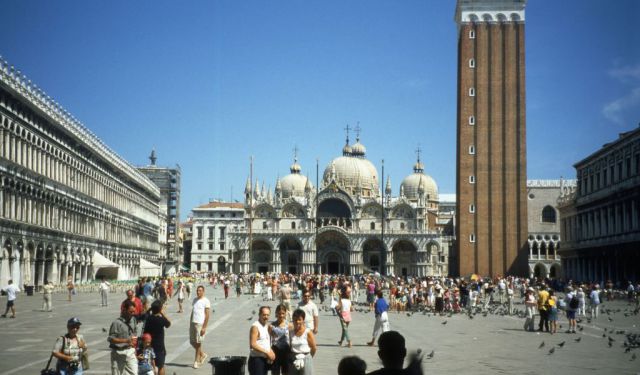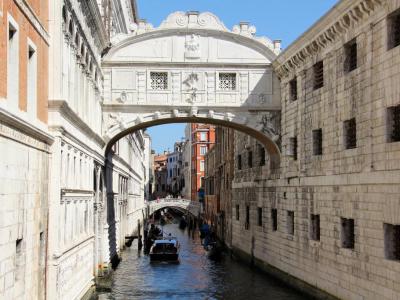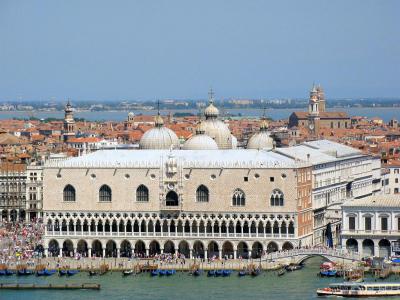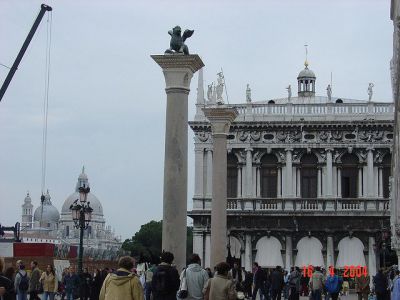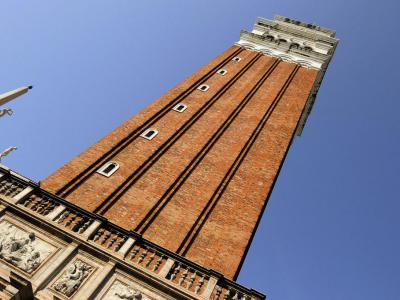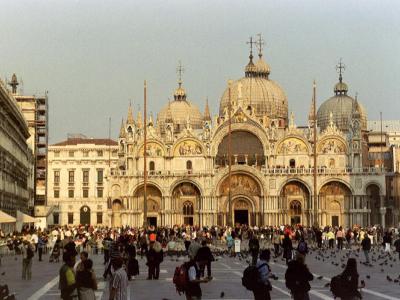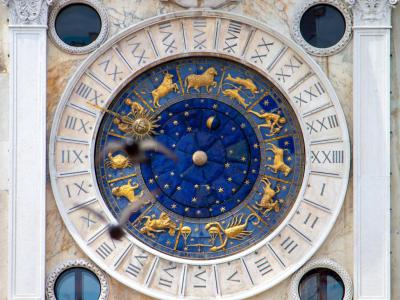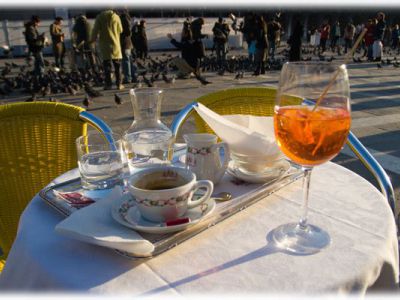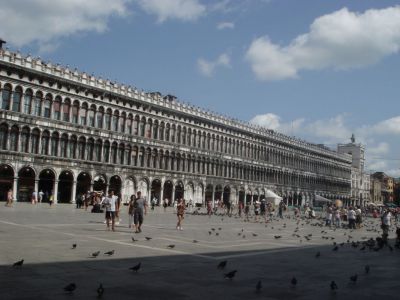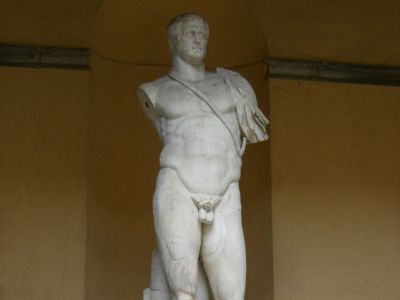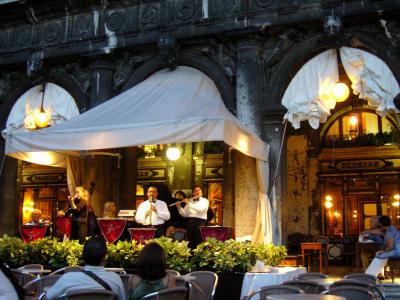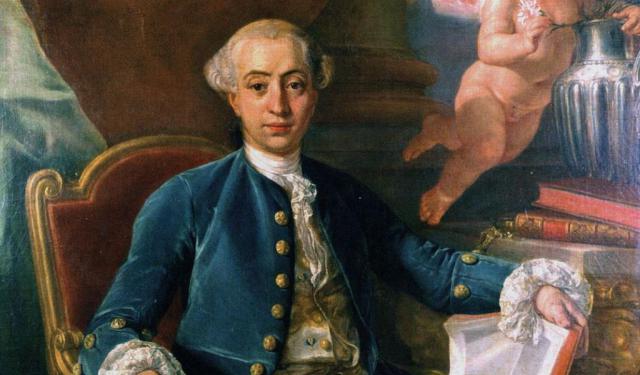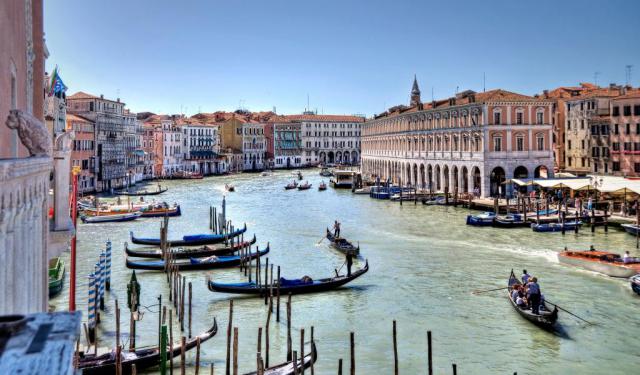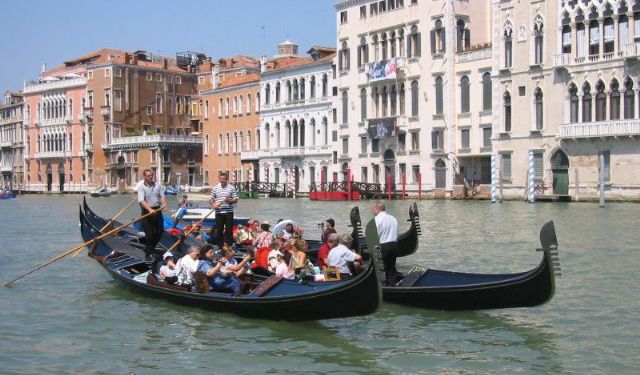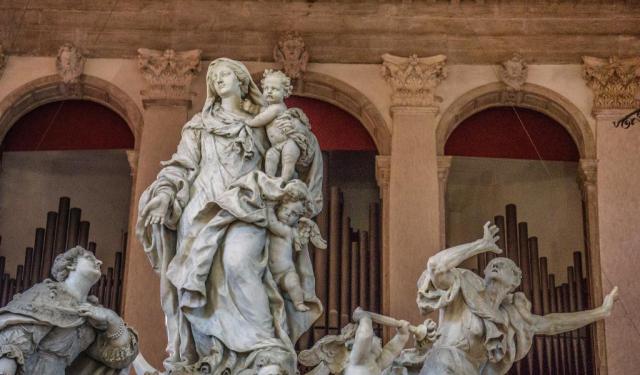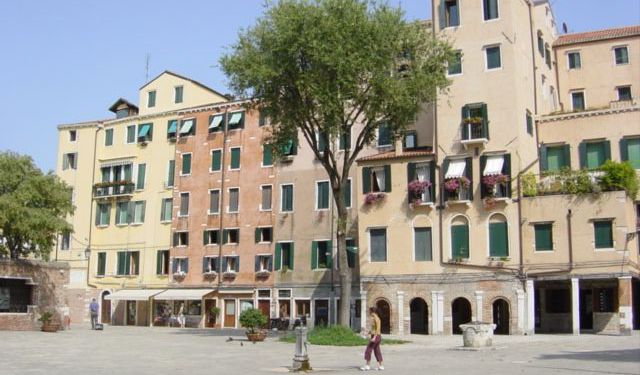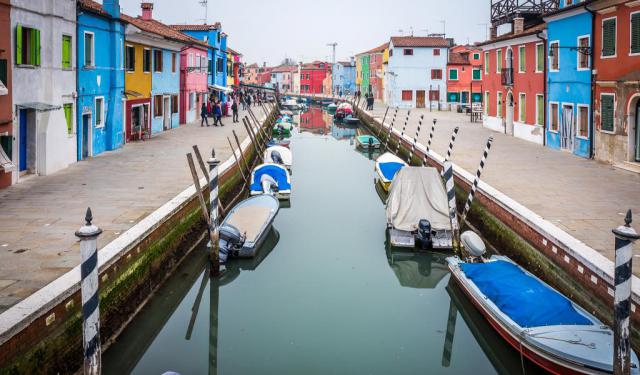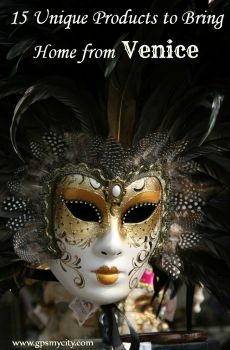Piazza San Marco Walking Tour (Self Guided), Venice
All of Venice’s roads seem to run into Piazza San Marco – the commercial, religious, and political heart of the city. With a glowing reputation as one of the finest squares in the world and arguably one of Europe’s primary tourist attractions, it certainly has a lot to offer to visitors.
Start your exploration with a tour of the pink-and-white marble Palazzo Ducale, which takes you through a succession of richly decorated chambers and halls, arranged over four floors. More than a palace, the Gothic-Renaissance structure also was the seat of government, housing a Senate and Court facilities. Interestingly, the prison, just over the canal, was connected to the court rooms via the enclosed Bridge of Sighs, which took its name in the 19th century, when visiting northern European poets romantically imagined the prisoners’ final breath of resignation upon viewing the outside world one last time.
Take time to carefully look at the exterior of San Marco Basilica, the jewel in Venice's gem-laden crown with a stunning combination of Byzantine and Roman architecture. From the top of its bell tower, towering high above the square, one can enjoy sublime views across the city, the lagoon and, sometimes, the peaks of the Italian Alpine range on the horizon.
Other highlights include the richly decorated Renaissance clock tower on the north side of the Piazza (Torre dell'orologio); the 16th-century Procuratie Vecchie, whose arched façade runs the full length of the square’s north-west side, and the Archeologico Museum’s strong collections of Imperial Roman artefacts.
Walk around, take photos and enjoy the atmosphere, all while taking in the history with this self-guided walking tour.
Getting to Sight #1. The first tour stop (Bridge of Sighs) can be reached by: Alilaguna Water Taxi: Blue, Rosa; Water Bus: 1, 4.1, 7, 4.2, 5.2, 2, 20 + N (Night line).
Start your exploration with a tour of the pink-and-white marble Palazzo Ducale, which takes you through a succession of richly decorated chambers and halls, arranged over four floors. More than a palace, the Gothic-Renaissance structure also was the seat of government, housing a Senate and Court facilities. Interestingly, the prison, just over the canal, was connected to the court rooms via the enclosed Bridge of Sighs, which took its name in the 19th century, when visiting northern European poets romantically imagined the prisoners’ final breath of resignation upon viewing the outside world one last time.
Take time to carefully look at the exterior of San Marco Basilica, the jewel in Venice's gem-laden crown with a stunning combination of Byzantine and Roman architecture. From the top of its bell tower, towering high above the square, one can enjoy sublime views across the city, the lagoon and, sometimes, the peaks of the Italian Alpine range on the horizon.
Other highlights include the richly decorated Renaissance clock tower on the north side of the Piazza (Torre dell'orologio); the 16th-century Procuratie Vecchie, whose arched façade runs the full length of the square’s north-west side, and the Archeologico Museum’s strong collections of Imperial Roman artefacts.
Walk around, take photos and enjoy the atmosphere, all while taking in the history with this self-guided walking tour.
Getting to Sight #1. The first tour stop (Bridge of Sighs) can be reached by: Alilaguna Water Taxi: Blue, Rosa; Water Bus: 1, 4.1, 7, 4.2, 5.2, 2, 20 + N (Night line).
How it works: Download the app "GPSmyCity: Walks in 1K+ Cities" from Apple App Store or Google Play Store to your mobile phone or tablet. The app turns your mobile device into a personal tour guide and its built-in GPS navigation functions guide you from one tour stop to next. The app works offline, so no data plan is needed when traveling abroad.
Piazza San Marco Walking Tour Map
Guide Name: Piazza San Marco Walking Tour
Guide Location: Italy » Venice (See other walking tours in Venice)
Guide Type: Self-guided Walking Tour (Sightseeing)
# of Attractions: 10
Tour Duration: 1 Hour(s)
Travel Distance: 0.6 Km or 0.4 Miles
Author: DanaOffice
Sight(s) Featured in This Guide:
Guide Location: Italy » Venice (See other walking tours in Venice)
Guide Type: Self-guided Walking Tour (Sightseeing)
# of Attractions: 10
Tour Duration: 1 Hour(s)
Travel Distance: 0.6 Km or 0.4 Miles
Author: DanaOffice
Sight(s) Featured in This Guide:
- Ponte dei Sospiri (Bridge of Sighs)
- Palazzo Ducale (Doge's Palace)
- Colonne di San Marco e San Todaro (Columns of St. Mark and St. Theodore)
- Campanile di San Marco (St. Mark's Bell Tower)
- Basilica di San Marco (St. Mark's Basilica)
- Torre dell'Orologio (Clock Tower)
- Caffe Lavena
- Procuratie Vecchie (Old Procuracies)
- Museo Archeologico Nazionale (National Archeological Museum)
- Caffe Florian
1) Ponte dei Sospiri (Bridge of Sighs)
Despite its relatively small size compared to other bridges in Venice, the Bridge of Sighs holds great significance as one of the city's most renowned and frequently visited structures. Constructed in 1600, this historical landmark spans across the Palace River ("Rio di Palazzo"), connecting the New Prison ("Prigioni Nuove") to the interrogation rooms in the Doge's Palace ("Palazzo Ducale"). Crafted from white limestone, it was designed by Antonio Contino, whose uncle Antonio da Ponte was the mastermind behind the iconic Rialto Bridge.
The bridge acquired its English name, the Bridge of Sighs, in the 19th century, bestowed by Lord Byron as a translation of the Italian "Ponte dei sospiri". The name stems from the notion that prisoners would sigh as they glimpsed their final view of the enchanting city of Venice through the windows before being led to their cells. In reality, by the time the bridge was constructed, the days of inquisitions and summary executions were gone, and the cells beneath the palace's roof primarily held minor offenders. Furthermore, little could be seen from inside the bridge due to the stone grills covering the windows.
According to local legend, couples who share a kiss on a gondola beneath the Bridge of Sighs at sunset, accompanied by the chimes of Saint Mark's bell tower, are destined to experience eternal love and happiness.
The bridge acquired its English name, the Bridge of Sighs, in the 19th century, bestowed by Lord Byron as a translation of the Italian "Ponte dei sospiri". The name stems from the notion that prisoners would sigh as they glimpsed their final view of the enchanting city of Venice through the windows before being led to their cells. In reality, by the time the bridge was constructed, the days of inquisitions and summary executions were gone, and the cells beneath the palace's roof primarily held minor offenders. Furthermore, little could be seen from inside the bridge due to the stone grills covering the windows.
According to local legend, couples who share a kiss on a gondola beneath the Bridge of Sighs at sunset, accompanied by the chimes of Saint Mark's bell tower, are destined to experience eternal love and happiness.
2) Palazzo Ducale (Doge's Palace) (must see)
Built on the foundations of a 9th-century fortress, this palace is unquestionably the finest secular European building of its time. Over the course of centuries, it has served many purposes, including Doge residence, seat of the Venetian government, court of law, civil office, and even a prison.
First built in the 14th century, much of the edifice was destroyed by fire in the 16th century, reducing to ashes most of the art treasures held inside. Some of the greatest Venetian masters of the time, such as Tintoretto, Veronese, Titian, Bellini, and Tiepolo, contributed to the restoration efforts, recreating gilded stucco, sculptures, frescoes, and canvases that returned the palace to its former glory.
Externally, the palace exhibits a blend of Byzantine and Gothic architectural styles, while the interior exudes Classical elements, leading art critic John Ruskin to proclaim it "the central building of the world". Inside, visitors are treated to a lavish display of furnishings, paintings, and elaborately adorned ceilings. Of notable grandeur is the Grand Council chamber, featuring Tintoretto's monumental "Paradise", reputedly the largest oil painting in the world. Equally magnificent is the Sala dello Scrutinio, or "Voting Hall," adorned with paintings depicting Venice's glorious past.
In stark contrast, the opposite side of the canal reveals the grim remnants of medieval justice-the prison cells. Linked to the outside world by the Bridge of Sighs ("Ponte dei Sospiri"), these cells serve as a haunting reminder of the horrors endured by prisoners who faced torture and potential death at the hands of the city's appointed state inquisitors. The term "sighs" refers to the lamentations of countless victims forced across the bridge.
To get the most of your time at the Doge's Palace, consider using the infrared audio guide available at the entrance, which provides a captivating narrative of the 1,000-year-old maritime republic of Venice and the intricacies of its former government.
***CASANOVA TOUR***
At the age of 30, on the fateful night of 25 July 1755, Casanova found himself arrested, accused of offending religion and common decency. Shockingly, he was sentenced to five years of imprisonment without even being granted a trial. His confinement took place in the Doge's Palace, where he was confined to a cell beneath the lead-covered roof. In the sweltering summer months, the oppressive heat turned his place of incarceration into an unbearable oven, further exacerbated by the torment of countless fleas infesting the premises.
Physically, Casanova was not far from the opulence of Venice and the seat of power, yet the psychological distance between his confinement and the world outside was immeasurable. Enduring 15 months of torment and despair, he finally hatched a daring plan to escape. Creating a hole in the ceiling, he ingeniously fashioned ropes from bed sheets and descended to freedom. This remarkable escape made Casanova the only person ever to break free from the prison of the Doge's Palace. Seeking sanctuary, he first sought refuge in Munich, then continued his journey to Strasbourg, eventually concluding his odyssey by coach to Paris, where he would start a new life.
Tip:
Make sure to book in advance for the guided "Secret Itinerary" tour – an exclusive experience grants access to otherwise restricted quarters and hidden passageways, including the Doge's private chambers, the interrogation rooms where prisoners were questioned, and the two cells once occupied by Casanova.
First built in the 14th century, much of the edifice was destroyed by fire in the 16th century, reducing to ashes most of the art treasures held inside. Some of the greatest Venetian masters of the time, such as Tintoretto, Veronese, Titian, Bellini, and Tiepolo, contributed to the restoration efforts, recreating gilded stucco, sculptures, frescoes, and canvases that returned the palace to its former glory.
Externally, the palace exhibits a blend of Byzantine and Gothic architectural styles, while the interior exudes Classical elements, leading art critic John Ruskin to proclaim it "the central building of the world". Inside, visitors are treated to a lavish display of furnishings, paintings, and elaborately adorned ceilings. Of notable grandeur is the Grand Council chamber, featuring Tintoretto's monumental "Paradise", reputedly the largest oil painting in the world. Equally magnificent is the Sala dello Scrutinio, or "Voting Hall," adorned with paintings depicting Venice's glorious past.
In stark contrast, the opposite side of the canal reveals the grim remnants of medieval justice-the prison cells. Linked to the outside world by the Bridge of Sighs ("Ponte dei Sospiri"), these cells serve as a haunting reminder of the horrors endured by prisoners who faced torture and potential death at the hands of the city's appointed state inquisitors. The term "sighs" refers to the lamentations of countless victims forced across the bridge.
To get the most of your time at the Doge's Palace, consider using the infrared audio guide available at the entrance, which provides a captivating narrative of the 1,000-year-old maritime republic of Venice and the intricacies of its former government.
***CASANOVA TOUR***
At the age of 30, on the fateful night of 25 July 1755, Casanova found himself arrested, accused of offending religion and common decency. Shockingly, he was sentenced to five years of imprisonment without even being granted a trial. His confinement took place in the Doge's Palace, where he was confined to a cell beneath the lead-covered roof. In the sweltering summer months, the oppressive heat turned his place of incarceration into an unbearable oven, further exacerbated by the torment of countless fleas infesting the premises.
Physically, Casanova was not far from the opulence of Venice and the seat of power, yet the psychological distance between his confinement and the world outside was immeasurable. Enduring 15 months of torment and despair, he finally hatched a daring plan to escape. Creating a hole in the ceiling, he ingeniously fashioned ropes from bed sheets and descended to freedom. This remarkable escape made Casanova the only person ever to break free from the prison of the Doge's Palace. Seeking sanctuary, he first sought refuge in Munich, then continued his journey to Strasbourg, eventually concluding his odyssey by coach to Paris, where he would start a new life.
Tip:
Make sure to book in advance for the guided "Secret Itinerary" tour – an exclusive experience grants access to otherwise restricted quarters and hidden passageways, including the Doge's private chambers, the interrogation rooms where prisoners were questioned, and the two cells once occupied by Casanova.
3) Colonne di San Marco e San Todaro (Columns of St. Mark and St. Theodore)
The monumental complex situated between the Doge's Palace ("Palazzo Ducale") and the Marciana Library ("Biblioteca Nazionale Marciana") showcases two grand pillars crafted from marble and granite. These pillars overlook the lagoon and bear statues of the city's two patrons: the winged lion, symbolizing Saint Mark the Evangelist, and Saint Theodore of Amasea, also known as Saint Tòdaro, the Byzantine saint and the city's original protector.
The origins of these statues in Venice remain steeped in mystery. Legend has it that they were brought from the East as spoils of war and were first erected in 1127 by Nicholas Barattieri. In recognition of his monumental achievement, the Government of the Republic rewarded him with exclusive rights to operate a gambling table between the two columns-an activity strictly forbidden within the Republic's territory. However, these privileges expired with Barattieri's passing.
Initially, there seem to have been three columns transported on separate boats. Regrettably, during the landing, one of the boats capsized, and the third column sank into the muddy depths of the lagoon. According to legend, it remains submerged to this day, as its immense size and weight dissuaded anyone from attempting the challenging task of retrieval.
After losing its status as a gambling zone, the site took on a new role during the 18th century. Public executions were conducted in this area, with the condemned individuals positioned to face the center of the square, their backs turned to the lagoon. As a result, Venetians developed a superstition and now avoid passing between the two columns.
The origins of these statues in Venice remain steeped in mystery. Legend has it that they were brought from the East as spoils of war and were first erected in 1127 by Nicholas Barattieri. In recognition of his monumental achievement, the Government of the Republic rewarded him with exclusive rights to operate a gambling table between the two columns-an activity strictly forbidden within the Republic's territory. However, these privileges expired with Barattieri's passing.
Initially, there seem to have been three columns transported on separate boats. Regrettably, during the landing, one of the boats capsized, and the third column sank into the muddy depths of the lagoon. According to legend, it remains submerged to this day, as its immense size and weight dissuaded anyone from attempting the challenging task of retrieval.
After losing its status as a gambling zone, the site took on a new role during the 18th century. Public executions were conducted in this area, with the condemned individuals positioned to face the center of the square, their backs turned to the lagoon. As a result, Venetians developed a superstition and now avoid passing between the two columns.
4) Campanile di San Marco (St. Mark's Bell Tower)
Venice's tallest bell tower was originally constructed in the 12th century. It served as a combined lighthouse and belfry and underwent continuous modifications until the 16th century when the golden angel was installed on its summit. Back in the day, each of the five bells served a specific purpose: the largest tolled to mark the beginning and end of the workday, another rang at midday, two others announced sessions of the Senate or called members of the Grand Council to meetings, and the smallest signaled an impending execution.
It was from the top of this belfry that Galileo Galilei famously showcased his telescope to the Venetian Doge in 1609 – a significant event commemorated by a plaque at the tower's observation deck. Still, the most dramatic episode associated with the Campanile occurred on July 14, 1902, when the tower collapsed shortly after giving a warning sound, causing the leisurely coffee drinkers below in the piazza to flee for their lives.
The Venetians put the Campanile back "where it was and how it was", and the tower is now safe to ascend all the way to the top. Unlike other belfries that require navigating narrow, steep spiral staircases, the Venetian one has an elevator allowing to effortlessly enjoy a pigeon's-eye view for a fee.
Rising 99 meters (325 feet) in height, the Campanile stands as the tallest structure in Venice, providing an ideal vantage point to admire the domes of Saint Mark's Basilica ("Basilica San Marco") and the surrounding lagoon. In the evenings, when the view is exceptionally clear, one can even observe distant landscapes for miles. However, even from the base of this historic bell tower, gazing up at its summit can be an equally thrilling experience.
It was from the top of this belfry that Galileo Galilei famously showcased his telescope to the Venetian Doge in 1609 – a significant event commemorated by a plaque at the tower's observation deck. Still, the most dramatic episode associated with the Campanile occurred on July 14, 1902, when the tower collapsed shortly after giving a warning sound, causing the leisurely coffee drinkers below in the piazza to flee for their lives.
The Venetians put the Campanile back "where it was and how it was", and the tower is now safe to ascend all the way to the top. Unlike other belfries that require navigating narrow, steep spiral staircases, the Venetian one has an elevator allowing to effortlessly enjoy a pigeon's-eye view for a fee.
Rising 99 meters (325 feet) in height, the Campanile stands as the tallest structure in Venice, providing an ideal vantage point to admire the domes of Saint Mark's Basilica ("Basilica San Marco") and the surrounding lagoon. In the evenings, when the view is exceptionally clear, one can even observe distant landscapes for miles. However, even from the base of this historic bell tower, gazing up at its summit can be an equally thrilling experience.
5) Basilica di San Marco (St. Mark's Basilica) (must see)
By far, the main draw for tourists visiting Venice is Saint Mark's Basilica. Its construction dates back to 832 AD when it was built to house the remains of Saint Mark, the city's patron saint. Legend has it that the holy man's body was brought from Alexandria, Egypt, hidden in barrels of pork meat, which the Venetian merchants believed the Muslim guards would never touch. Upon arrival in the lagoon, Saint Mark was said to be greeted by an angel who proclaimed that his body would find rest in that place. This legend has inspired numerous works of art throughout the centuries.
Two hundred years later, a magnificent temple was erected on the foundations of an earlier church and consecrated when Saint Mark's body was laid to rest beneath the high altar. The new basilica was designed after the renowned Church of the Apostles in Constantinople. To enhance its splendor, the structure was adorned with marble and mosaics depicting scenes from the Old and New Testaments, as well as the lives of Christ, the Virgin Mary, and Saint Mark himself.
Over time, many of the mosaics were retouched or replaced as artistic tastes evolved and damaged mosaics needed restoration. As a result, the current mosaics represent a span of 800 years of artistic styles. Some mosaics reflect traditional Byzantine representations and stand as masterpieces of medieval art, while others were based on preparatory drawings by renowned Renaissance artists from Venice and Florence, such as Paolo Veronese, Tintoretto, Titian, Paolo Uccello, and Andrea del Castagno.
Andrea del Castagno, active at San Marco in the mid-15th century, introduced a sense of perspective largely achieved with architectural settings. One of his notable contributions is the mosaic in the Mascoli Chapel, depicting the "Dormition of the Virgin". Tintoretto, on the other hand, created the mosaic in the central nave depicting the "Presentation of Jesus at the Temple" in the 16th century, while Titian designed and executed the mosaic decoration of the Sacristy vault between 1524 and 1530, depicting Old Testament prophets.
Inside the basilica, there are additional spots that can be visited for a separate fee, including the Golden Altar, the Museum, the Treasury, and the Crypt. It is highly recommended to pay for access to the first level, offering elevated views of the interior and the square outside. Alternatively, consider taking a night tour when the basilica is closed to the public, allowing you to have the entire place to yourself.
Entry to the basilica is free, but for a small fee, you can skip the line and book a time slot.
Why You Should Visit:
To witness the exceptional blend of Byzantine and Western art, showcased through the grandeur of the mosaics and the richness of the 'treasure room', offering insights into the immense power and wealth of Venice during its golden era.
Tip:
The best time to visit is around midday when the golden mosaics adorning the vaults, walls, and cupolas are illuminated and at their most spectacular. The lights are only turned on for a limited time (11:30am-12:30pm), so be sure to plan your visit accordingly to witness and appreciate the mosaics at their best.
Two hundred years later, a magnificent temple was erected on the foundations of an earlier church and consecrated when Saint Mark's body was laid to rest beneath the high altar. The new basilica was designed after the renowned Church of the Apostles in Constantinople. To enhance its splendor, the structure was adorned with marble and mosaics depicting scenes from the Old and New Testaments, as well as the lives of Christ, the Virgin Mary, and Saint Mark himself.
Over time, many of the mosaics were retouched or replaced as artistic tastes evolved and damaged mosaics needed restoration. As a result, the current mosaics represent a span of 800 years of artistic styles. Some mosaics reflect traditional Byzantine representations and stand as masterpieces of medieval art, while others were based on preparatory drawings by renowned Renaissance artists from Venice and Florence, such as Paolo Veronese, Tintoretto, Titian, Paolo Uccello, and Andrea del Castagno.
Andrea del Castagno, active at San Marco in the mid-15th century, introduced a sense of perspective largely achieved with architectural settings. One of his notable contributions is the mosaic in the Mascoli Chapel, depicting the "Dormition of the Virgin". Tintoretto, on the other hand, created the mosaic in the central nave depicting the "Presentation of Jesus at the Temple" in the 16th century, while Titian designed and executed the mosaic decoration of the Sacristy vault between 1524 and 1530, depicting Old Testament prophets.
Inside the basilica, there are additional spots that can be visited for a separate fee, including the Golden Altar, the Museum, the Treasury, and the Crypt. It is highly recommended to pay for access to the first level, offering elevated views of the interior and the square outside. Alternatively, consider taking a night tour when the basilica is closed to the public, allowing you to have the entire place to yourself.
Entry to the basilica is free, but for a small fee, you can skip the line and book a time slot.
Why You Should Visit:
To witness the exceptional blend of Byzantine and Western art, showcased through the grandeur of the mosaics and the richness of the 'treasure room', offering insights into the immense power and wealth of Venice during its golden era.
Tip:
The best time to visit is around midday when the golden mosaics adorning the vaults, walls, and cupolas are illuminated and at their most spectacular. The lights are only turned on for a limited time (11:30am-12:30pm), so be sure to plan your visit accordingly to witness and appreciate the mosaics at their best.
6) Torre dell'Orologio (Clock Tower) (must see)
In a square filled with iconic Venetian buildings, this remarkable Renaissance clock tower holds its own. Its base has always been a favored meeting point for Venetians, as it marks the entrance to the ancient Merceria, one of the busiest streets in Venice, now hosting both upscale boutiques and souvenir shops.
The clock itself has served as the official timekeeper of Venice since 1858. Notably, it not only tells the time but also aids the astrologer by aligning zodiac signs with the position of the sun.
Above the clock's face, against a backdrop of golden stars, you can see the winged lion of Saint Mark, a symbol of Venice found practically everywhere around the city. Beneath the lion, a statue of the Virgin Mary and Baby Jesus appears to watch over Saint Mark's Square.
The two figures striking the bell at the very top of the clock tower are among the most peculiar characters in Venice. Originally depicted as two shepherds, over time the bronze statues darkened, earning them the nickname "Moors".
If you decide to climb the tower, it is advisable to book a tour. Two English-language tours are conducted daily, with each limited to only 12 participants. During the tour, you will have the opportunity to observe the clock mechanism and other intriguing elements within the tower, including a secret door, as you ascend to the top, where you can marvel at the view of Saint Mark's Square below.
The clock itself has served as the official timekeeper of Venice since 1858. Notably, it not only tells the time but also aids the astrologer by aligning zodiac signs with the position of the sun.
Above the clock's face, against a backdrop of golden stars, you can see the winged lion of Saint Mark, a symbol of Venice found practically everywhere around the city. Beneath the lion, a statue of the Virgin Mary and Baby Jesus appears to watch over Saint Mark's Square.
The two figures striking the bell at the very top of the clock tower are among the most peculiar characters in Venice. Originally depicted as two shepherds, over time the bronze statues darkened, earning them the nickname "Moors".
If you decide to climb the tower, it is advisable to book a tour. Two English-language tours are conducted daily, with each limited to only 12 participants. During the tour, you will have the opportunity to observe the clock mechanism and other intriguing elements within the tower, including a secret door, as you ascend to the top, where you can marvel at the view of Saint Mark's Square below.
7) Caffe Lavena
Dating back to 1750, Caffè Lavena traces its origins to the vibrant Venice of the 18th century. Like other renowned cafés in Saint Mark's Square, Lavena played an integral role in the city's intellectual and cultural life. A distinguished figure who brought prestige to the establishment, patronizing it since his first visit to Venice, was the renowned composer Richard Wagner. Almost every day, between five and six in the afternoon, Wagner would stay for half an hour, often engaging in conversations with the owner, Carlo Lavena.
Numerous other famous individuals have frequented Lavena over the years, including the Venetian violinist Raphael Frontalli, esteemed composers, writers, and a host of both renowned and lesser-known movie stars who visit during the annual Venice Film Festival.
The caffè still stands as one of the top-tier establishments in Saint Mark's Square, forming a prestigious trio alongside Quadri and Florian. For privacy, you can opt for a table in the narrow little gallery that overlooks the mirrored bar-a delightful Baroque setting. The coffee is of excellent quality, and you can reduce the cost by opting to enjoy yours at the bar, where a few euros will cover the cost, in contrast to the over €10 charge for outdoor seating. However, for an unforgettable experience of savoring caffè corretto (coffee "corrected" with liquor) accompanied by the melodious tunes of Lavena's nimble violinists, it is certainly worth indulging in a seat in the lively square.
Numerous other famous individuals have frequented Lavena over the years, including the Venetian violinist Raphael Frontalli, esteemed composers, writers, and a host of both renowned and lesser-known movie stars who visit during the annual Venice Film Festival.
The caffè still stands as one of the top-tier establishments in Saint Mark's Square, forming a prestigious trio alongside Quadri and Florian. For privacy, you can opt for a table in the narrow little gallery that overlooks the mirrored bar-a delightful Baroque setting. The coffee is of excellent quality, and you can reduce the cost by opting to enjoy yours at the bar, where a few euros will cover the cost, in contrast to the over €10 charge for outdoor seating. However, for an unforgettable experience of savoring caffè corretto (coffee "corrected" with liquor) accompanied by the melodious tunes of Lavena's nimble violinists, it is certainly worth indulging in a seat in the lively square.
8) Procuratie Vecchie (Old Procuracies)
Located to the left of the Clock Tower ("Torre dell'Orologio"), the Old Procuracies building stretches forth. This magnificent structure was once the residence of the Procurators of San Marco, a prestigious position responsible for overseeing the maintenance of San Marco and the management of other government-owned properties. The number of procurators never exceeded nine, and they held the second-highest position in the Venetian hierarchy, following only the Doge, who often rose from their ranks. Alongside the Doge and the Grand Chancellor, who headed the civil service, the procurators held the exclusive distinction of being the only state officials elected for life.
Since the time of Doge Ziani, the procurators and their accompanying bureaucracies were situated on this side of Saint Mark's Square. The current building, however, was initiated around 1500 by Codussi, continued after a fire in 1512, and eventually completed around 1532 by Sansovino. Its most captivating architectural feature is the presence of 100 small round arches adorning the windows and the archways along the expansive veranda. Within these archways, you will now discover some of Venice's most renowned, historic, and upscale cafes.
Since the time of Doge Ziani, the procurators and their accompanying bureaucracies were situated on this side of Saint Mark's Square. The current building, however, was initiated around 1500 by Codussi, continued after a fire in 1512, and eventually completed around 1532 by Sansovino. Its most captivating architectural feature is the presence of 100 small round arches adorning the windows and the archways along the expansive veranda. Within these archways, you will now discover some of Venice's most renowned, historic, and upscale cafes.
9) Museo Archeologico Nazionale (National Archeological Museum)
In 1523, Cardinal Domenico Grimani bestowed upon the City of Venice a remarkable collection of sculptures and ancient artworks, some of which came from ancient Greece, Egypt, and Assyria-Babylon. Continuing from that, the National Archeological Museum now houses an exceptional array of Imperial Roman artifacts, including coins dating back to the earliest years of the Republic. Among other highlights is the collection of Roman funerary sculptures, or you may want to focus on other nearby sections featuring Napoleon's Palace rooms, works by Bellini, exhibits depicting Venetian life, weaponry and armor displays, ship-building artifacts, and items that once belonged to the Doge's Palace.
Certain pieces from the Grimani collections stand out due to their exceptional nature. Keep an eye out for the striking head of Athena from the 4th century BC, a trio of wounded Gallic warriors (Roman copies of Hellenistic originals), and busts depicting a range of Roman emperors such as Domitian, Vitellius, Hadrian, Trajan, Tiberius, Marcus Aurelius, Septimius Severus, and the infamous Caracalla.
At the far end of the museum, a door opens into the hall of Sansovino's library with its beautifully designed ceilings, ornate decorations, and exquisite architectural details.
Tip:
The M.A.N. is part of the museum complex in Saint Mark's Square, allowing visitors to explore multiple attractions with a single ticket. This ticket includes access to the Doge's Palace, the Correr Museum, and the Monumental Rooms of the Marciana Library.
Certain pieces from the Grimani collections stand out due to their exceptional nature. Keep an eye out for the striking head of Athena from the 4th century BC, a trio of wounded Gallic warriors (Roman copies of Hellenistic originals), and busts depicting a range of Roman emperors such as Domitian, Vitellius, Hadrian, Trajan, Tiberius, Marcus Aurelius, Septimius Severus, and the infamous Caracalla.
At the far end of the museum, a door opens into the hall of Sansovino's library with its beautifully designed ceilings, ornate decorations, and exquisite architectural details.
Tip:
The M.A.N. is part of the museum complex in Saint Mark's Square, allowing visitors to explore multiple attractions with a single ticket. This ticket includes access to the Doge's Palace, the Correr Museum, and the Monumental Rooms of the Marciana Library.
10) Caffe Florian
Established in 1720 by Florian Francesconi and lauded by Napoleon as "one of the world's most beautiful drawing rooms", Caffè Florian holds the distinction of being the oldest continuously operating coffee house in Italy and the second oldest in the world (after Café Procope in Paris). Due to its prestigious position, it is almost a symbol of Venice; the meeting place of artists and poets, writers and politicians, including Wagner, Goethe, and Lord Byron. Casanova, known for his keen interest in pursuing connections with women, particularly favored the establishment, largely due to the fact that it was one of the first in Venice to allow women entry-an opportunity he eagerly embraced in his romantic endeavors.
Here, immersed in a rich local history, one can enjoy an amazing range of cakes and coffees, albeit at a higher price point, served by elegantly attired waiters at small marble tables for two. The experience is undeniably delightful, particularly when the resident musicians serenade the patrons (one of the primary reasons for choosing this café); however, be aware that an additional €6 per person will be added to your bill during musical performances. The ambiance is tranquil and inviting, aside from the occasional visits from birds that may seek some attention. You can even make song requests to the musicians or admire the art exhibitions within the cafe's walls.
Here, immersed in a rich local history, one can enjoy an amazing range of cakes and coffees, albeit at a higher price point, served by elegantly attired waiters at small marble tables for two. The experience is undeniably delightful, particularly when the resident musicians serenade the patrons (one of the primary reasons for choosing this café); however, be aware that an additional €6 per person will be added to your bill during musical performances. The ambiance is tranquil and inviting, aside from the occasional visits from birds that may seek some attention. You can even make song requests to the musicians or admire the art exhibitions within the cafe's walls.
Walking Tours in Venice, Italy
Create Your Own Walk in Venice
Creating your own self-guided walk in Venice is easy and fun. Choose the city attractions that you want to see and a walk route map will be created just for you. You can even set your hotel as the start point of the walk.
Casanova's Venice
One of Venice's most famous personalities, Giacomo Casanova is remembered today as a womanizer, but was much more than that. Born in a family of theater actors in 1725, he came through as highly intellectual and very sharp from his very childhood, having become in his time an erudite scholar, a diplomat and spy, and a metropolitan ‘avant la lettre’, who frequented the high society and... view more
Tour Duration: 2 Hour(s)
Travel Distance: 4.5 Km or 2.8 Miles
Tour Duration: 2 Hour(s)
Travel Distance: 4.5 Km or 2.8 Miles
Venice Introduction Walking Tour
Although most experts agree that the Venetian lagoon emerged nearly 6,000 years ago, the area of today's Venice remained mostly uninhabited, except for a small population of fishermen, up until the 5th century AD when the hordes of Gothic barbarians, looting their way into Rome, drove many a people away from their homes on the mainland to take refuge on the coastal Venetian islands.
Those... view more
Tour Duration: 3 Hour(s)
Travel Distance: 4.1 Km or 2.5 Miles
Those... view more
Tour Duration: 3 Hour(s)
Travel Distance: 4.1 Km or 2.5 Miles
Grand Canal Walking Tour
The main waterway in Venice, Grand Canal snakes in an "S" shape through the center of the city, dividing its main districts. On both sides of this thoroughfare are the most beautiful buildings dating from the 12th to the 18th centuries that tell the story of a thousand years of Venetian splendor. While one can view the architectural parade from water buses, our self-guided walking tour... view more
Tour Duration: 3 Hour(s)
Travel Distance: 5.2 Km or 3.2 Miles
Tour Duration: 3 Hour(s)
Travel Distance: 5.2 Km or 3.2 Miles
Venice's Hidden Art Treasures
Among the first things springing to mind when talking about Venice, apart from the canals and gondolas, of course, is Art and Architecture. Indeed, Venice is one of the few cities in the world where Art and Architecture have merged in a stunning multiplicity of forms. The city is even renowned for its unique (Venetian) pictorial school famed by the likes of Tintoretto, Titian, Veronese, Castagno... view more
Tour Duration: 2 Hour(s)
Travel Distance: 3.6 Km or 2.2 Miles
Tour Duration: 2 Hour(s)
Travel Distance: 3.6 Km or 2.2 Miles
Jewish Ghetto Tour
Founded in 1516, the Jewish Ghetto in Venice was the oldest of its kind in all Europe. At the time, Venice received order from the Pope to expel all Jews from the city, but the Venetian government opted to lock them onto a small island in the district of Cannaregio. Since then this small area has been the center of Jewish life in Venice, with buildings rising vertically to accommodate the rising... view more
Tour Duration: 1 Hour(s)
Travel Distance: 0.4 Km or 0.2 Miles
Tour Duration: 1 Hour(s)
Travel Distance: 0.4 Km or 0.2 Miles
Murano Island Walking Tour
Murano is often called the Glass Island, since it is home to the most impressive and renowned Venetian glass factories. The master craftsmen here have preserved their centuries-old techniques, and the island is full of shops where you can admire and purchase their adorable glass items. Some factories, such as Gino Mazzuccato’s, at the start of this self-guided walk, even have special showrooms... view more
Tour Duration: 1 Hour(s)
Travel Distance: 2.3 Km or 1.4 Miles
Tour Duration: 1 Hour(s)
Travel Distance: 2.3 Km or 1.4 Miles
Useful Travel Guides for Planning Your Trip
15 Distinctively Italian Things to Buy in Venice
Venice has been a tourist mecca for over a century now, with millions of visitors flocking in every year to see this unique place on the face of the Earth. Many, if not all, of these people seek to obtain something memorable as a token of their stay in this city. By far, not all of them know which...
The Most Popular Cities
/ view all
